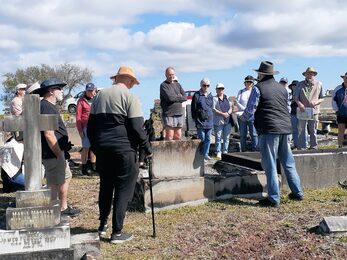Sutherland Shire Council acknowledges the Dharawal speaking people who are the Traditional Custodians of the land of Sutherland Shire.
Council pays respect to the Elders past and present of the Dharawal nation and extends that respect to other Aboriginal people visiting this site.
Archaeologists and Anthropologists suggest that Aboriginal people lived in the Sydney/Illawarra coastal areas for more than 10,000 years before the arrival of Lt. Cook. Some evidence for the Sydney region and Parramatta River indicate that it may have been as long as 30,000 years.
Prior to the arrival of the HMB Endeavour and later the First Fleet, the area around Sutherland was populated by the many Clans of the Dharawal and Gandangara language groups, the Australian Aboriginal people whose traditional tribal areas stretched from the south-eastern shore of Botany Bay and along the Georges River as far south as the Shoalhaven River and west from Menai down to about Mossvale.
The most prominent clans of the Sutherland region were the Gweagal and Norongeragal people. These people gathered plant foods, fished and hunted in this area. They lived in small communities of about 15 to 20 people.
There were some larger villages reported by early explorers (Phillip, Tench and others) of up to 12 huts and 60 peoples around Cooks River, with the largest being that of the Bidigal clan of the Dharug speaking peoples from around Parramatta down to Tempe.
The Dreamtime or Dreaming is an important concept in Aboriginal culture. According to Aboriginal belief, all life as it is today – human, animal, bird and fish are part of one vast unchanging network of relationships which can be traced to the Great Spirit ancestors of the Dreamtime.
There is a dreaming that tells the arrival story of the Dharawal speaking people. Evidence in the Royal National Park suggests that Aboriginals lived in the area about 7450 years before present, making it one of the oldest coastal sites in the Sydney region.
The Gweagal people lived mainly by the salt water bays and estuaries of Port Hacking, they also used the fresh water resources of the upper Hacking River, Heathcote Creek and the Woronora River.
The Gweagal people were said to be the guardians of the sacred white clay pits on their territorial land, now known as the Kurnell Peninsula. They used the clay to make body paint, medicine and when mixed with local berries it was also used as a dietary supplement.
The tribe also looked out for whales from the Kurnell Peninsula. The whale was a dreaming figure for the Dharawal and an integral part of their community and beliefs. The connection appears to be the role that whales played as 'bringers of vast foods'. Rock engravings of their totem still exist on the plateaus where the elders once looked out for the whales to arrive.
Dharawal rock art including drawings, paintings and hand stencils, as well as rock engravings, grinding grooves and shell middens are present throughout the Shire.
The region we know as the Sutherland Shire began on 29 April 1770 when Lieutenant (later Captain) James Cook, on his first epic voyage of scientific exploration anchored His Majesty's Bark Endeavour in Botany Bay. At the time of Cook’s arrival, the Gweagal people were hunting and fishing at Kurnell. To the Gweagal the Endeavour appeared to be a big white bird, no doubt an astonishing and fearful sight. Unknowingly to Cook and the Gweagal people, Kurnell within the Sutherland Shire was destined to become the meeting of two cultures.
Botany Bay was one of three sites considered for a convict settlement by the British parliament on recommendations from Joseph Banks. In 1788 when the First Fleet arrived, a decision was made to settle at Port Jackson, now Sydney Harbour, a little further north than the Sutherland Shire.
In 1795 and 1796 two young British naval adventurers George Bass and Matthew Flinders (who would eventually circumnavigate the continent and name it 'Australia'), made fleeting explorations south of Port Jackson to the Georges River, Port Hacking and the Illawarra in their small boat ‘Tom Thumb’.
The area changed dramatically when Thomas Holt, an aspiring feudal lord and wealthy business man acquired the Sutherland Estate over a period of 12 years from 1861 - 1875. Holt built the sandstone obelisk at Kurnell in 1870 to commemorate Cook’s landing.
In 1885 a rail line was opened to Sutherland crossing the Georges River at Como. Visitors from Sydney flocked by train to Como Pleasure Grounds and beyond to Cronulla, Port Hacking and the National Park. In 1879 The National Park was established, the first in Australia and second in the world. The prefix Royal was added after a visit by Queen Elizabeth in 1955.
In 1906 the Sutherland Shire was proclaimed. As surfing and bathing had become popular, the following year Councillors and citizens cooperated to form the Cronulla Surf Life Saving Club. Their first clubhouse was an old tramcar. By 1929 the Georges River was bridged by road at Tom Ugly's Point and in 1939 a rail line was extended from Sutherland to Cronulla.
Rapid development occurred in the 20th Century, as the Shire became a popular place to live, work and holiday. Today it offers locals and visitors an ideal blend of cosmopolitan culture and the natural world. This coastal area melts into rich national park bushland and hidden waterways.
The Shire still retains much of its original natural beauty. The sandstone cliffs bordering the Pacific and the coastal national parks still look much the same as when Cook sailed along its coastline in 1770.

Explore the Sutherland Shire on our interactive map
Explore here
Join local history expert Clive Baker and other guides from the Shire Military History Club and disc...
Read More
Cycling in the Sutherland Shire
Read More